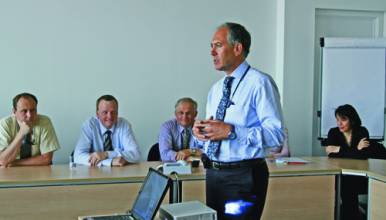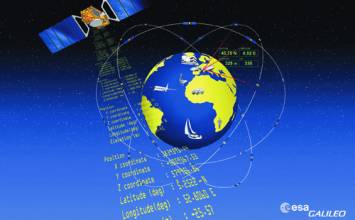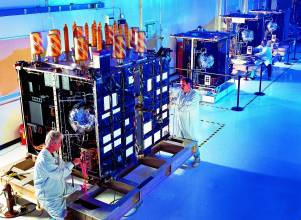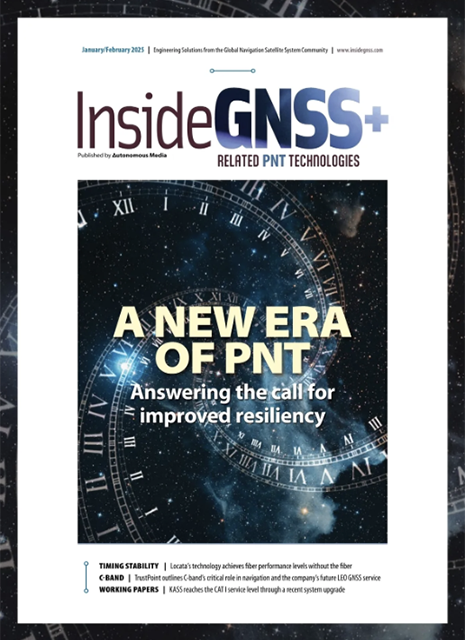July 1, 2006
GPS has had enormous benefits to the economy and society that go well beyond military and civil aviation applications – that is becoming ever more widely understood. What has been more open to discussion are the civilian non-aviation benefits of further U.S. efforts at GPS modernization, particularly the introduction of additional signals.
GPS has had enormous benefits to the economy and society that go well beyond military and civil aviation applications – that is becoming ever more widely understood. What has been more open to discussion are the civilian non-aviation benefits of further U.S. efforts at GPS modernization, particularly the introduction of additional signals.
In an effort to define and measure civilian benefits, the U.S. departments of commerce and transportation commissioned some economic analyses of civil signal modernization. Particular emphasis was placed on the value of the L2C signal centered at 1227.60 MHZ, which recently began broadcasting from the first modernized GPS Block IIR-M satellite. This article is an outgrowth of that effort.
The analysis focused on the value of signals at more than one frequency for precision non-aviation use by business and government. It considered how utilization of the second civilian signal and its benefits would evolve in the coming decades as the L2C constellation expands and as additional signals become available from GPS and other GNSSes.
In the study, projections were developed under four scenarios — with the “moderate benefit”scenario seeming most likely — that reflect combinations of developments, including the strength of markets, the timing of L2C signal availability, the timing of Galileo availability, and complementary and competitive relationships with augmentations.
The main findings of the study are:
- The projected number of U.S. high precision users of any signal nearly doubles from 39,000 to 75,000 from 2004 to 2008, and reaches 146,000 in 2012 and 333,000 in 2017.
- Under a “moderate benefits” scenario, the number of L2C users reaches 64,000 by 2017, of which 35,000 are dual frequency users and 29,000 use three or more frequencies.
- Civilian benefits of L2C net of user costs range from $1.4-$9.6 billion under alternative scenarios and civilian net benefits are about $5.8 billion under the moderate benefits scenario.
- Positive present values of benefits net of user costs are obtained in all tests.
- The ratio of benefits to user costs ranges from 8 to 20 in all tests.
In addition to the domestic benefits examined, L2C will undoubtedly have important international benefits.
This article presents in more detail how we defined the problem, approached the study, and arrived at those conclusions.
The L2C Evolution
L2C, together with the present L1 C/A-code signal and the future modernized civil signal L1C, will provide an alternative to augmented single frequency GPS for precision users. Separate investigations have outlined the incremental benefits of L1C (See sidebar, “The L1C Studies,” at the end of this article)
L2C signals can be used for both horizontal and vertical measurement and positioning along with L1 C/A as satellites become available over more areas and in more times of the day. The first satellite can be used for improved timing. L2C also can be used in configurations of three or more frequencies in combination with the forthcoming GPS L5 signal and with signals from Galileo and GLONASS.
At various times in each signal’s deployment and development of markets, other signals will, to varying degrees, provide complements to L2C and competitors to it. L2C has its greatest potential to generate benefits for dual frequency applications until alternative signals are widely utilized, and for long-term use in applications taking advantage of three or more frequencies.
The L2 signal is currently being widely used for augmentations, and the new signals can be used in that way along with the existing constellation. However, L5’s use as a competitor to L2C and as a partner to L2C in multiple frequency implementations primarily depends on the launch timeline for satellites carrying the L5 signal since L5, centered at the 1176.45 MHz frequency, is not currently in service. Plans call for its implementation on the GPS Block IIF satellites, with the first IIF now expected to be launched in 2008.
L2C deployment requires a commitment to operational capability. Decisions will be required as to launch dates and signal activation for each successive satellite containing the signal. The L2C benefits study is intended to contribute to decisions about L2C deployment with consideration of alternative scenarios informed by quantitative and qualitative analysis.
To explore the implications of L2C evolution, we make projections about the numbers of U.S. precision users, incremental benefits, and user costs, based on examination of applications and available evidence on value of benefits, and consider how these can unfold over the period 2006–2030.
The analysis focuses on precision users of L2C who use two or more frequencies, although we do include estimates for supplementary multiple-frequency users and single-frequency users. However, the estimates of these types of use are more conjectural and do not contribute much to the overall value of benefits.
Benefits net of user costs are measured according to the widely accepted economic productivity approach, which includes productivity gains and cost savings. This comprehensive approach is more appropriate than one that measures benefits simply by expenditures on equipment and services.
Incremental benefits and user costs are defined to include all differences in outcomes from what would be expected in the absence of L2C.
Signal Advantages and Availability
The L2C signal, scheduled to be the first of the modernized civil GPS signals, is intended for civilian purposes other than aviation and safety-of-life. It will provide greater accuracy and robustness and faster signal acquisition than the current L1 C/A-code signal.
Higher signal power and forward error correction will improve GPS mobile, indoor, and other uses.
The L5 signal that will arrive within a few years will be in a protected aeronautical radionavigation system (ARNS) band intended for aviation and other safety-of-life uses and will have broader applications.
Multiple signals will allow many users to obtain greater precision and availability at lower cost than achievable with proprietary augmentation systems. However, signal combinations combined with public and private augmentations for even greater precision and reliability will support applications with some of the greatest potential benefits.
Combined use of L2C with L1 C/A and L5 will also enable some precision users to achieve even greater reliability and accuracy. Although available simulations differ on the size of benefits of three signals over two, many professionals expect important advantages from such “tri-laning” techniques.
The U.S. Air Force launched first satellite containing the L2C frequency on September 25, 2005, and the signal became available on December 16. Going forward, two to four Block IIR-M satellites are expected to be launched each year. With six to eight satellites anticipated to be available by about December 2007, users will be able to access at least one single satellite with L2C at almost all times. Eighteen L2C-capable satellites (including the Block IIF generation) will be available by about 2011 and 24 L2C signals, around 2012. (These statements are based on official 2005 launch schedules and are subject to revision.)
The first L5 launch is scheduled for March 2008. L5 does not have a GPS signal in use at its frequency, so it will not be usable to any great extent until a large part of its constellation is available. In contrast, L2 is in place to transmit the military P(Y) code and the carrier signals of the satellites are currently being used along with L1 C/A for higher-accuracy applications.
Consequently, the L2C signal can be used immediately as a second frequency. The GPS signal L1C, which is being planned now for implementation on the GPS III satellites scheduled for launch beginning in 2013, will be able to be used immediately, even for single frequency use, without augmentation because it is at the same frequency as the L1 C/A-code.
Using Multiple Frequency GPS
Many private and government precision applications could potentially benefit from multiple frequency GPS.
For example:
- Centimeter accuracy is important to many land and marine surveying applications including planning, zoning, and land management; cadastral surveying, harbor and port mapping, aids to navigation, coastal resources management, mapping, and surveys of sensitive habitats.
- Machine control applications using high precision GPS have grown rapidly in a number of sectors, including agriculture and forestry, mining, construction, energy, transportation, structural monitoring and positioning for mapping and geographic modeling..
- Civil applications that rely on precise timing will benefit from increased GPS signal availability and elimination of atmospheric effects possible using dual-frequency techniques. Beneficiary industries include those operating cellular telephone, power, and financial information networks.
Scope of Benefits and Costs
Incremental benefits — those that arise because of the availability of L2C— include far more than the comparison of multiple frequency with augmented single frequency use. Companies adopting GPS in the future may even skip single-frequency options and instead choose multiple-frequency equipment (incorporating L2C) over non-GPS alternatives. Large candidate markets include construction, agriculture, and other applications where technological alternatives exist.
In some organizations, dual-frequency GPS will be the catalyst for extensive changes in systems that will occur earlier than if dual frequency GPS had not been adopted.
In the L2C study, benefits are measured according to the “economic productivity approach,” which is superior to the expenditure/economic impact approach because:
- Productivity gains and cost savings, which this approach emphasizes, are the main purpose of much of GPS deployment and can be much larger than expenditures.
- Benefits may accrue to a large number of customers of the purchaser, as occurs with use of GPS timing in communications, financial services, and electric power and in use of GPS positioning for mapping, structural monitoring, and weather.
- The more common approach (economic impact) gauges benefits by added GPS spending without deducting the loss of benefits of non-GPS expenditures that are replaced.
L2C benefits can take both market and non-market forms, including increases in the productivity of business and government operations, user cost savings, benefits to the public through provision of public services and saving lives, and through improved health and environment.
Net benefits are benefits minus user costs. Incremental user costs include all additional costs that are expected with the availability of L2C, not simply the difference in costs between single- and dual-frequency receivers. These can take the forms of enhancements and accessories purchased when adding L2C capability (e.g. better displays, controllers and software) or costs associated with users upgrading to multiple frequency GPS from less sophisticated single-frequency GPS systems or non-GPS systems.
However, incremental user cost is net of savings from use of receivers with less proprietary technology and any reduced use of private augmentation subscription services.
Expenditures to develop the GPS system infrastructure (satellites and ground segment) are not included, however, because most represent nonrecurring, sunk costs. Moreover, if we added them to our L2C analysis, we would need to include benefits to aviation and military users as well as their associated equipment costs.
Scenarios
The analysis takes into account alternative conditions of timing and impact of alternatives through the use of scenarios. Projections of signal use and value of benefits are developed through the year 2030 under four scenarios: High Opportunity, Moderate Benefits, Diluted Benefits, and Opportunity lost.
These scenarios reflect combinations of developments, including the strength of markets, the timing of L2C signal availability, the timing of Galileo availability, and complementary and competitive relationships with augmentations. (See the sidebar, “L2C Benefit Scenarios” at the end of this article for details of assumptions behind each.)
Probabilities are not given for the scenarios because the likelihood of alternative Galileo delays cannot be evaluated quantitatively. Moreover, the diluted benefits and opportunity lost scenarios are significantly affected by U.S. GPS policy, which is also not predicted.
Estimates of GPS Users
The L2C study projections shown in Figure 1 are based on assumed rates of decline in prices for user equipment and services and increases in the number of users in response to price changes. Projections reflect assessments of market sizes and patterns of market penetration under each scenario. Allowance also is made for effects of economic growth on market size. Table 1 (to view tables and figures, please download the PDF of this article using the link above) provides a detailed breakdown of results by scenario.
Within each scenario, projections are made for precision L2C users of three or more frequencies, dual frequency precision users, multiple frequency supplementary users, and single frequency users of L2C.
The starting point for determining the number of high precision users is a widely relied–upon estimate of 50,000 high precision users worldwide in 2000. We assumed that the United States had 40 percent of precision users in that year.
The study further assumes that the number of U.S. high-precision GPS users will grow by 18 percent per year from 2000 to 2030. This projection is based on a rate of price decline for user equipment of 15 percent per year and a corresponding a 1 percent increase in users for each 1 percent decline in price. Finally, we include an assumption of general growth in the economy (i.e., independent of GPS receiver price) that adds 3 percent per year.
These assumptions and calculations produce a projection of U.S. high precision GPS users — those using augmentations, of 38,776 in 2004. The estimated number of U.S. high precision users of any signal or combination nearly doubles to 75,177 from 2004 to 2008 and reaches 145,752 in 2012 and 333,445 in 2017.
We computed the numbers of multi-frequency GPS users by applying an estimated percentage to the number of high-precision users for each scenario. The number of multi-frequency precision users adopting dual versus three or more frequencies was then calculated using projected values for the percent of each category. Finally, the number of L2C users was calculated based on projections of the percent of multiple frequency users that use L2C, constructed to reflect the dynamics of each of the scenarios.
Rapid growth is projected in the numbers of U.S. precision multiple-frequency L2C users. In the moderate benefits scenario, the number of L2C users reaches 64,000 by 2017, of which 35,000 are dual frequency users and 29,000 use three or more frequencies. The numbers of L2C users vary widely among scenarios.
Average Net Benefits per User
The study defines average incremental net value of benefits per L2C user as the incremental value of benefits per L2C user above the incremental user cost of equipment and services. Benefits largely reflect productivity gains and/or cost savings. Estimates reflect a review of available evidence ranging from formal studies to case histories and expert opinion across a wide range of applications.
Our research suggests that average annual incremental benefit per precision L2C user net of costs could reach the range of $8,000–$16,000 per year. This includes benefits across systems that are not attributable to specific numbers of users and non-market benefits, such as safety and environmental advantages, as well as market benefits associated with the value of goods and services transactions. Market benefits attributable to numbers of users are estimated at 60 percent of all incremental net benefits.
These are peak values after benefits have had an opportunity to rise with experience using the new signal. The values decline from their peaks as new users with lower benefits are attracted by declining costs and some high benefit users move to alternatives.
In considering the plausibility of these figures, consider that:
- If a worker saved one hour a week by avoiding rescheduling due to signal unavailability, slow signal acquisition, loss of lock and additional work due to phase ambiguities, and further assuming labor costs of $80 per hour (including salary, fringe benefits, equipment, support staff and other overheads), — the saving would total $4,000 per year. Improvements in the organization’s processes with better work flow could make the savings even greater.
- If the telecommunications, electricity generation, and financial industries together had system benefits that together were valued at $20 per customer over 20 million customers, the benefits would be $400 million per year. Market benefits of $400 million per year, if divided by 100,000 dual frequency users, for example, would amount to an average of $4,000 per user per year.
- $400 million in non-market benefits over 100,000 precision users would equal an additional $4,000 per user per year.
(This could result, for example, from avoiding 100 deaths due to industrial accidents or environmental impacts at a value of $4 million per incident.)
The present values of incremental user costs range among scenarios from $175 million to $514 million in year 2005 purchasing power.
Costs represent one eighth or less of the total value of benefits in each scenario.
Value of Benefits
Civilian net benefits per user are incremental, net of incremental costs, and derive from prospects for major areas of application. The patterns incorporate some high-value initial use, assume that higher benefit users switch earlier to newer signals, factor in a buildup of productivity gains with experience, and project lower values for late-entry users attracted by lower equipment prices as well as later increases in higher benefit users switching to alternative signals.
We calculate the value of civilian net benefits of L2C through multiplying civilian net benefits per user by the number of L2C users for the user type and scenario. Higher net benefit scenarios result from higher benefits per user and larger numbers of users.
At a 7 percent real (above inflation) discount rate, present values of total net civilian market benefits range from $9.6 billion to $1.4 billion dollars. Benefits under the moderate benefits scenario have a present value of $5.8 billion and those under the high opportunity scenario $9.6 billion. (Values are discounted using annual data to calendar year 2006. That essentially places the values at the middle of 2006.)
Nearly all of the incremental benefits of L2C stem from precision use of two or more frequencies. That is both because of moderate numbers of other types of users in these and their low benefits per user.
The timeframe in which other signals become available after L2C plays an important role in the size of estimated benefits. In the high opportunity scenario, for example, dual-frequency net benefits appear higher than benefits from use of three or more frequencies because the latter applications start later as additional frequencies become available.
In the other scenarios, benefits from applications using three or more signals are higher than dual-frequency benefits because the benefits of dual frequency remain as strong when competing frequencies become available.
New spending can encourage greater long run economic growth, especially when it is associated with new technology for widely usable infrastructure. The spending may induce others to innovate, invest in greater capacity, take risks and/or provide financing. While direct estimates of the size of long run economic multipliers are not readily available, analyses of determinants of growth suggest that effects are modest, perhaps adding 20% to market benefits. Because of the uncertainty surrounding such estimates, no allowance is made for growth multiplier effects in the estimates shown.
Cost-Benefit Analysis
The ratio of incremental civilian benefits to user costs is calculated by dividing the present discounted value of total incremental benefits (including net benefits and costs) by the present value of incremental costs. These are shown with a 7% real (above inflation) discount rate.
The ratios of benefits to costs range from a multiple of 20 in the high opportunity scenario to 9 in the opportunity lost scenario. It would be surprising if benefit/cost ratios were not high because only direct user expenses (and not system costs) are included to get a picture of incremental costs of each set of outcomes.
The moderate benefits scenario, which has a ratio of 20, is considered more likely than the others. Because of the interest in obtaining the greatest benefits, focusing on the present value of net benefits is appropriate for policy rather than using the benefit/cost ratio when all ratios are high.
As mentioned, changes in various factors could substantially affect the outcomes of L2C benefits and produce either an overstatement or an understatement of these. See the “Benefit Variables” sidebar at the end of this article for a listing of the most important factors.
Conclusions
Rapid growth is projected in the numbers of U.S. precision GPS users and in most scenarios for the numbers of high-precision multiple frequency L2C users. Substantial L2C benefits can occur along with availability of other signals and constellations, augmentations, and alternative technologies. While Galileo will compete with L2C, Galileo signals also can increase precision L2C use in multiple frequency applications, an alternative that will become increasingly affordable.
The economic productivity approach offers a means of considering benefits in a comprehensive way. Benefits and costs are incremental. They are defined to include all changes that occur as a result of the existence of L2C.
Defined comprehensively, benefits can encompass results from more extensive changes in equipment and systems and include both benefits that are attributable to specific numbers of users and those that may be incorporated in systems and spread over a broad population. They include both market and non-market benefits — those that are not bought and sold in markets, such as benefits to life, health, security and the environment.
User costs also are incremental, including all changes that occur with the availability of L2C, and are net of savings from moving to less sophisticated and less proprietary equipment.
Sidebar: The L1C Studies
Before the L2C study, important progress had already been made in understanding the benefits of additional GPS signals. These activities included the discussion of civilian applications in the report of the Defense Science Board Task Force on GPS, released last December, and the L1C Study undertaken by the Interagency GPS Executive Board in 2004. (See the “Additional Resources” section at the end of this article to find out how to obtain these studies on line.)
Upper limits of total benefits of L1C for the single year 2005 — including those obtained by single- and multiple-frequency users in private households, businesses, governments — were estimated at approximately $2 billion: $640 million for mobile and wireless location services, $62.5 million for information/data services, $990 million for “commercial GPS,” and $490 million for in-vehicle information and navigation services (telematics).
The L1C study approximated a “rough order of magnitude” dollar value of L1C applications based on 2005 spending by applying a “team consensus” for an assumed incremental benefit as a percentage of market value (revenue) for each of 13 user categories. Spending in user group categories was based on a compilation of trade estimates.
Sidebar: L2C Benefit Scenarios
The four scenarios developed to support the L2C benefits study, along with the assumptions underling each, include the following:
High Opportunity
- Timely signal availability
- Larger than expected markets
- High complementarity with L5
- Success of High-Accuracy Nationwide Differential GPS augmentation
- Full Galileo deployment in 2012 with less than complete technical performance
Moderate Benefits
- Benefits moderated by competition from other signals and augmentations
- Full Galileo deployment in 2011
Diluted Benefits
- Gradual L2C deployment and uncertainty about schedules slows investment in innovation and market development
- Many users wait for L5 and for Galileo, which is expected in 2010
- Improvements in public and private augmentations make single signal use more attractive
Opportunity Lost
- Late signal initiation and protracted pace of L2C deployment
- Slow introduction and adoption of user equipment
- Some users wait for Galileo
- Moderately large potential market size, moderate effects of availability of other signals and delay in Galileo FOC to 2011
- Attractiveness of augmentations
Sidebar: Benefit Variables
Overstatement could result from competition from other signals, from augmentations and from other technologies that is greater than anticipated. For example,
- Greater attractiveness of other signals because of the availability of satellites from Galileo in addition to those from GPS at the L1 and L5 frequencies
- Advances in augmentations that make single frequency use more attractive
- Slower price declines for L2C user equipment
- Less triple frequency use when additional satellites are available from Galileo and/or greater use of Galileo signals at frequencies that do not correspond with L1 and L5
- More users waiting for L5 for non-aviation civilian dual frequency use than allowed for in the study.
Understatement could result from
- More important and/or numerous applications than were allowed for in the calculations
- Faster price declines for multiple frequency user equipment (e.g. if competition squeezes high end margins even more) and/or larger price sensitivity of demand
- Non-market benefits greater than the 25% of market benefits assumed
- Impacts of L2C on long run economic growth, which were not included in the calculations and perhaps could add perhaps 20% to benefits.
For figures, graphs, and images, please download the PDF of the article, above.
Acknowledgments
Steve Bayless, Tyler Duval, Jason Kim, Scott Pace, Mike Shaw, Tom Stansell, Dave Turner, Jack Wells, Rodney Weiher, and Avery Sen offered comments, guidance and assistance to the study. Many others contributed expertise through interviews.
Additional Resources
Kenneth W. Hudnut, and Bryan Titus, GPS L1 Civil Signal Modernization (L1C), Interagency GPS Executive Board, July 30, 2004, <http://www.navcen.uscg.gov/gps/modernization/L1/L1C-report-short.pdf>
U.S. Defense Science Board, The Future of the Global Positioning System, Washington, D.C.: Office of the Under Secretary of Defense For Acquisition, Technology, and Logistics, October 2005, <http://www.acq.osd.mil/dsb/reports/2005-10-GPS_Report_Final.pdf>
By









